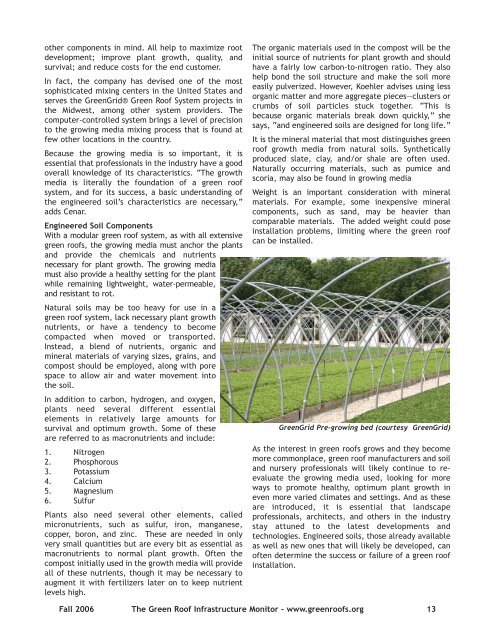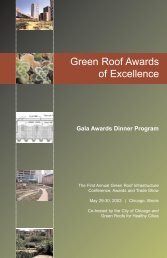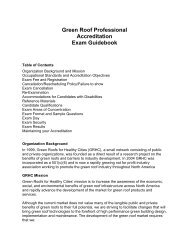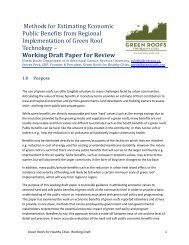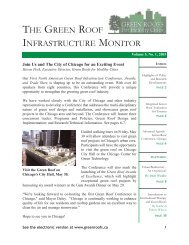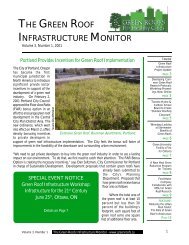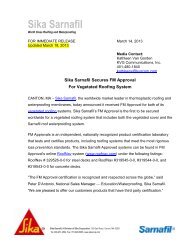Fall 2006 Sep 20.qxp - Green Roofs for Healthy Cities
Fall 2006 Sep 20.qxp - Green Roofs for Healthy Cities
Fall 2006 Sep 20.qxp - Green Roofs for Healthy Cities
Create successful ePaper yourself
Turn your PDF publications into a flip-book with our unique Google optimized e-Paper software.
other components in mind. All help to maximize root<br />
development; improve plant growth, quality, and<br />
survival; and reduce costs <strong>for</strong> the end customer.<br />
In fact, the company has devised one of the most<br />
sophisticated mixing centers in the United States and<br />
serves the <strong>Green</strong>Grid® <strong>Green</strong> Roof System projects in<br />
the Midwest, among other system providers. The<br />
computer-controlled system brings a level of precision<br />
to the growing media mixing process that is found at<br />
few other locations in the country.<br />
Because the growing media is so important, it is<br />
essential that professionals in the industry have a good<br />
overall knowledge of its characteristics. “The growth<br />
media is literally the foundation of a green roof<br />
system, and <strong>for</strong> its success, a basic understanding of<br />
the engineered soil’s characteristics are necessary,”<br />
adds Cenar.<br />
Engineered Soil Components<br />
With a modular green roof system, as with all extensive<br />
green roofs, the growing media must anchor the plants<br />
and provide the chemicals and nutrients<br />
necessary <strong>for</strong> plant growth. The growing media<br />
must also provide a healthy setting <strong>for</strong> the plant<br />
while remaining lightweight, water-permeable,<br />
and resistant to rot.<br />
Natural soils may be too heavy <strong>for</strong> use in a<br />
green roof system, lack necessary plant growth<br />
nutrients, or have a tendency to become<br />
compacted when moved or transported.<br />
Instead, a blend of nutrients, organic and<br />
mineral materials of varying sizes, grains, and<br />
compost should be employed, along with pore<br />
space to allow air and water movement into<br />
the soil.<br />
In addition to carbon, hydrogen, and oxygen,<br />
plants need several different essential<br />
elements in relatively large amounts <strong>for</strong><br />
survival and optimum growth. Some of these<br />
are referred to as macronutrients and include:<br />
1. Nitrogen<br />
2. Phosphorous<br />
3. Potassium<br />
4. Calcium<br />
5. Magnesium<br />
6. Sulfur<br />
Plants also need several other elements, called<br />
micronutrients, such as sulfur, iron, manganese,<br />
copper, boron, and zinc. These are needed in only<br />
very small quantities but are every bit as essential as<br />
macronutrients to normal plant growth. Often the<br />
compost initially used in the growth media will provide<br />
all of these nutrients, though it may be necessary to<br />
augment it with fertilizers later on to keep nutrient<br />
levels high.<br />
The organic materials used in the compost will be the<br />
initial source of nutrients <strong>for</strong> plant growth and should<br />
have a fairly low carbon-to-nitrogen ratio. They also<br />
help bond the soil structure and make the soil more<br />
easily pulverized. However, Koehler advises using less<br />
organic matter and more aggregate pieces—clusters or<br />
crumbs of soil particles stuck together. “This is<br />
because organic materials break down quickly,” she<br />
says, “and engineered soils are designed <strong>for</strong> long life.”<br />
It is the mineral material that most distinguishes green<br />
roof growth media from natural soils. Synthetically<br />
produced slate, clay, and/or shale are often used.<br />
Naturally occurring materials, such as pumice and<br />
scoria, may also be found in growing media<br />
Weight is an important consideration with mineral<br />
materials. For example, some inexpensive mineral<br />
components, such as sand, may be heavier than<br />
comparable materials. The added weight could pose<br />
installation problems, limiting where the green roof<br />
can be installed.<br />
<strong>Green</strong>Grid Pre-growing bed (courtesy <strong>Green</strong>Grid)<br />
As the interest in green roofs grows and they become<br />
more commonplace, green roof manufacturers and soil<br />
and nursery professionals will likely continue to reevaluate<br />
the growing media used, looking <strong>for</strong> more<br />
ways to promote healthy, optimum plant growth in<br />
even more varied climates and settings. And as these<br />
are introduced, it is essential that landscape<br />
professionals, architects, and others in the industry<br />
stay attuned to the latest developments and<br />
technologies. Engineered soils, those already available<br />
as well as new ones that will likely be developed, can<br />
often determine the success or failure of a green roof<br />
installation.<br />
<strong>Fall</strong> <strong>2006</strong> The <strong>Green</strong> Roof Infrastructure Monitor - www.greenroofs.org<br />
13


